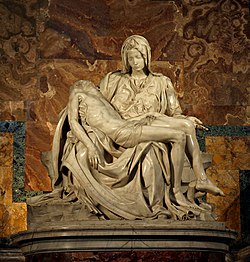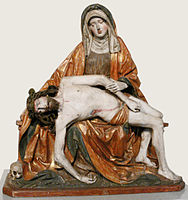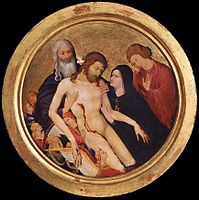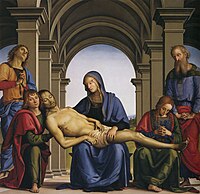Pietà


The Pietà (Italian pronunciation: [pjeˈta]; meaning "pity", "compassion") is a subject in Christian art depicting the Virgin Mary cradling the dead body of Jesus after his body was removed from the cross. It is most often found in sculpture. The Pietà is a specific form of the Lamentation of Christ in which Jesus is mourned by the Virgin Mary alone.[1]
Context and development[]

Pietà is one of the three common artistic representations of a sorrowful Virgin Mary, the other two being Mater Dolorosa (Mother of Sorrows) and Stabat Mater (the mother was standing).[2][3] The other two representations are most commonly found in paintings, rather than sculpture, although combined forms exist.[4]
The Pietà developed in Germany (where it is called the "Vesperbild") about 1300, reached Italy about 1400, and was especially popular in Central European Andachtsbilder.[5] Many German and Polish 15th-century examples in wood greatly emphasise Christ's wounds. The Deposition of Christ and the Lamentation or Pietà form the 13th of the Stations of the Cross, as well as one of the Seven Sorrows of the Virgin.
Although the Pietà most often shows the Virgin Mary holding Jesus, there are other compositions, including those where God the Father participates in holding Jesus (see gallery below). In Spain the Virgin often holds up one or both hands, sometimes with Christ's body slumped to the floor.
Michelangelo[]

A famous example by Michelangelo was carved from a block of marble and is located in St. Peter's Basilica in the Vatican City. The body of Christ is different from most earlier Pietà statues, which were usually smaller and in wood. The Virgin is also unusually youthful, and in repose, rather than the older, sorrowing Mary of most Pietàs. She is shown as youthful for two reasons; God is the source of all beauty and she is one of the closest to God, also the exterior is thought as the revelation of the interior (the virgin is morally beautiful). Michelangelo's Pieta sculpture is also unique in the fact that it is the only one of his works that he ever signed. Upon hearing that visitors thought it had been sculpted by Cristoforo Solari, a competitor.[6] His signature is carved as MICHAELA[N]GELUS BONAROTUS FLORENTIN[US] FACIEBA[T] "Michelangelo Buonarroti the Florentine did it".[7]
In a lesser known Michelangelo Pietà, The Deposition (c. 1547–1555), it is not the Virgin Mary who is holding Jesus' body, but rather Nicodemus (or possibly Joseph of Arimathea), Mary Magdalene, and the Virgin Mary. There is some indication that the man in the hood is based on a self-portrait of the artist.[8] The sculpture is housed in the Museo dell'Opera del Duomo in Florence and is also known as the Florentine Pietà.
A generation later, the Spanish painter Luis de Morales painted a number of highly emotional Pietàs,[9] with examples in the Louvre and Museo del Prado.
Gallery[]
Statues, statuettes and paintings[]
Austrian Pietà, c. 1420

15th-century German wood Pietà from Cologne

German or Netherlandish 15th Century, Pietà, c. 1450–1500, National Gallery of Art

Swabian painted wood Pietà of c. 1500
Dieffler Pietà, Wooden sculpture, presumably 15th or 18th century, former chapel of St Wendelin in Diefflen, Saarland Museum, Old Collection

Pietà by Gregorio Fernández, 1616–1619, National Sculpture Museum,
18th-century Bavarian example with Rococo setting

The Palestrina Pietà originally attributed to Michelangelo but probably by another sculptor

A Pietà in marble by Johan Rice, 1897

Pieta Tondo Jean Malouel
Jean Malouel, Pieta Tondo

Pietà in frescoes found in the Church of St. Panteleimon, Gorno Nerezi, 1164

The Avignon Pietà, Enguerrand Charonton, 15th century

Kraków, c. 1450

Rogier van der Weyden, Museo del Prado, Madrid, with Saint John and a donor, c. 1440-1450

Pietro Perugino, Uffizi, 1490

Deposition of Christ, Bronzino, 1540–1545, Musée de Besançon

El Greco, Pietà, 1571–1576, Philadelphia Museum of Art

Pietà, c.1600, Annibale Carracci, National Museum of Capodimonte

Pieta, 1876, William-Adolphe Bouguereau

Bogdan Cierpisz, Pieta, c.1980
See also[]
References[]
- ^ "Pietà". National Galleries of Scotland.
- ^ Arthur de Bles, 2004 How to Distinguish the Saints in Art by Their Costumes, Symbols and Attributes ISBN 1-4179-0870-X page 35
- ^ Anna Jameson, 2006 Legends of the Madonna: as represented in the fine arts ISBN 1-4286-3499-1 page 37
- ^ E.g. see Noël Quillerier's at Oratorio della Nunziatella
- ^ G Schiller, Iconography of Christian Art, Vol. II,1972 (English trans from German), Lund Humphries, London, pp. 179–181, figs 622–39, ISBN 0-85331-324-5
- ^ William E. Wallace, 1995 Life and Early Works (Michelangelo: Selected Scholarship in English) ISBN 0-8153-1823-5 page 233
- ^ "Pieta by Michelangelo". www.michelangelo.net.
- ^ "The Deposition by Michelangelo". www.michelangelo.net.
- ^ "Luis de Morales - Artworks". www.the-athenaeum.org.
Further reading[]
- Forsyth, William F. (1995). The Pietà in French late Gothic sculpture: regional variations. New York: The Metropolitan Museum of Art. ISBN 0-87099-681-9.
External links[]
| Look up pietà in Wiktionary, the free dictionary. |
| Wikimedia Commons has media related to Pietà. |
- Pietà
- Christian terminology
- Italian words and phrases




















